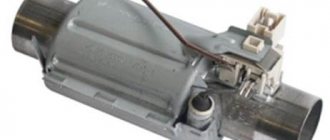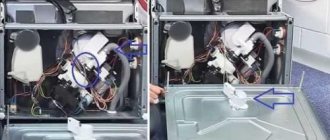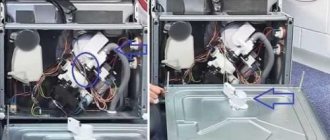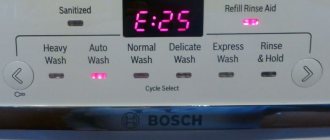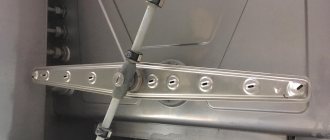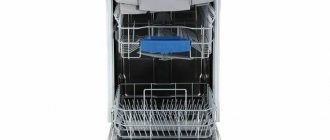Sink dimensions
A compact under-sink dishwasher should be selected taking into account the width of the sink. The standard dimensions of a sink in a small apartment do not exceed 55 centimeters in width. To fit into such a limited space, the dishwasher must be slightly narrower.
Another important parameter is the height of the cabinet. The outer height is usually 80-85 cm, but the internal volume will be significantly less due to the siphon and the depth of the bowl.
If the distance from the bottom point of the siphon to the floor is less than 30-40 centimeters, not a single dishwasher will fit under the sink. Then the installation will require complete dismantling of the structure with a corresponding change in its dimensions.
Dishwasher parameters
The main characteristics of the machine sizes vary from 45 cm. Not a single company in the world produces machines for our standard sinks with a width of less than 30 and a height of less than 40 cm - it is impossible to equip with all the working elements in such a small space.
The average dimensions of a dishwasher cannot be less than 44 x 50 x 50, and all these data are interdependent. For example, with a depth of 50, the width cannot be less than 55, and in reverse order.
As for the external design, built-in appliances are in greatest demand, since in this case it is not necessary to dismantle the cabinet door.
But you can see what a narrow built-in dishwasher with a width of 40 cm looks like here.
But if the dimensions of the internal space allow, then you can find a free-standing model that will fit into the dimensions of your space under the sink.
Here's a video of what the dishwasher looks like in place:
Dishwasher dimensions
The smallest and narrowest dishwasher for installation under the sink cannot be lower than 40, much less 30 centimeters. Such devices would not be technically functional - a 30 cm machine would not provide normal capacity . Models with heights from 44 to 60 cm are usually produced.
The required dimensions for a minimum capacity for 4 sets of dishes are 44x50x50 cm. In practice, width and depth are interdependent - if the depth is 50 cm, then the width will be 55 cm and vice versa.
Advantages and disadvantages of compact dishwashers
If you have a small kitchen, you should think about buying a compact dishwasher.
The product has a number of advantages:
- saves time and money;
- will not take up much space;
- consumes little electricity and water;
- can be built under the sink, does not clutter up the space;
- simple and easy to use.
A portable dishwasher is ideal for young families and single people.
There are also disadvantages of the device:
- There are models that create a lot of noise and have poor cleaning quality;
- not all have a rinsing function;
- high price;
- not all dishes can be washed (exceptions are wooden products, plastic, rusting steel);
- It is inconvenient to wash large objects (pots, pans).
Disadvantages are minimized if you take the choice of device seriously.
Advantages of under-sink installation
This option provides several important advantages that are excluded when choosing full-size analogues:
- saving space;
- affordable price;
- preservation of kitchen design.
But not all the advantages that are mentioned in the reviews are true. This applies to low water and electricity consumption.
A full washing cycle requires almost the same water and electricity consumption as full-size machines. In this case, the savings are insignificant, so the impact on costs is insignificant.
Functionality
When buying a machine, you need to pay attention to the technical characteristics that will ensure its high-quality operation. Inexpensive models have a minimum of programs and functions, which limits their capabilities. To avoid this, the dishwasher must have:
- water filling control system (Aquastop);
- effective drying - this can be the most expensive turbo option or budget drying based on the principle of evaporation;
- normal noise level is about 40 dB;
- required set of programs - the minimum includes delicate, standard, intensive modes;
- child lock;
- reliable filtration system;
- convenient control - electronic or mechanical.
Installation Rules
Following simple installation rules will ensure uninterrupted operation of the dishwasher, as well as comfortable operating conditions. In addition, a correctly installed device will not disturb the interior of the kitchen. For installation you will need:
- Select a possible connection to the water supply. It is better to use a special tee.
- Connect the drain hose through a siphon with a dishwasher outlet. When connecting, do not allow kinks.
- Install the electrical outlet at an accessible safe distance.
- Level the device horizontally using adjustable feet or any other available method.
- Check for leaks.
If all the rules are followed and the device is working normally, you can begin its daily operation.
Popular models
In order for the machine to work for a long time, it is not enough to choose good technical characteristics; you also need to select the device by brand. The latter will be a guarantee of quality and reliability.
A cheap dishwasher system from an unknown manufacturer seems to be a good deal. But that's not true. The high operational risks will quickly make you realize why this is not the best choice.
Branded devices with a good reputation and positive reviews include models from Bosch and Electrolux .
Bosch SKS50E32EU
A high-quality and functional device with good performance characteristics. It is classified as free-standing, but can be installed as a built-in one due to its small dimensions of 45x55x50.
Pros:
- decent capacity - holds 6 sets;
- five operating modes;
- low noise.
Minuses:
- no work program timer;
- Eco mode is too long - lasts 2 hours 40 minutes.
Electrolux ESF2200DW
The compact machine is slightly less than 44 cm in height. The overall dimensions are 43.8x55x50 cm. It features reduced power consumption.
Advantages:
- long drain hose, expanding the choice of installation location for the device;
- many operating modes for high-quality dishwashing;
- There is a basket for cutlery and shelves for cups.
Flaws:
- noisy work;
- Some users complain about poor drying of dishes.
Compact dishwashing machines
Choice
Note. Household units of this type can be of different sizes, but we need a compact dishwasher under the sink, therefore, we will give preference to the lowest models.
- BOSCH SKS50E32EU has a power consumption of 2400W, burns 0.61kW/hour (174kW/year) and belongs to class A+ for energy saving, the average water consumption here is 8 liters per day (one process) and 2240 liters per year . You can load 6 sets of dishes into the machine, which are washed and rinsed with five programs operating in five temperature modes. The list of programs consists of: “fast”, “normal”, “intensive”, “economical” and “delicate”.
- The length of the drain hose here is 2.25 m, the water supply hose is 1.5 m, and the electrical cable is 1.7 m long . There is also a basket for cutlery and a shelf for cups. The dimensions of the unit in terms of height/width/depth are 450x551x500 mm. Weight 21 kg net and 24 kg gross.
ELECTROLUX ESF 2200 DW
- ELECTROLUX ESF 2200 DW has a power consumption of 1180 W (138.6 kW/year) and belongs to class A in terms of energy saving, the average water consumption here is 8 liters per day (one process) and 2240 liters per year . You can load 6 sets of dishes into the machine, which are washed and rinsed with five programs operating in six temperature modes. The list of programs consists of: “eco 55”, “intensive 70”, “normal 65”, “fast 40”, “fast 45”, “rinse” and “standby”.
- The length of the drain hose here is 2.25 m, the water supply hose is 1.5 m, and the electrical cable is 1.7 m long . There is also a basket for cutlery and a shelf for cups. The dimensions of the unit in terms of height/width/depth are 438x550x500 mm.
ELECTROLUX ESF 2300 OS
- ELECTROLUX ESF 2300 OS, probably the smallest or one of the smallest machines, has a power consumption of 1200 W and belongs to class A/A/B in terms of energy saving, the average water consumption here is 8 liters per day (one process) and 2240 liters per year . You can load 6 sets of dishes into the machine, which are washed and rinsed with five programs operating in five temperature modes. The list of programs consists of: “automatic program 45-70⁰C”, “intensive wash 70⁰C”, “quick 50⁰C”, “rinse”, “eco 55⁰C” and “glass 40⁰C”.
- The length of the drain hose here is 2.25 m, the water supply hose is 1.5 m, and the electrical cable is 1.7 m long . There is also a basket for cutlery and a shelf for cups. The dimensions of the unit in terms of height/width/depth are 474x545x515 mm.
Note. It is quite possible that you will find a unit with smaller dimensions, but the most important thing is that the machine is built-in and fits in a cabinet under or near the sink.
How to install
The main obstacle to installing a dishwasher under the sink is the siphon
The standard height of kitchen cabinets is 80-85 cm from the floor to the countertop, but these are external dimensions, and we are interested in the size of the box from the inside, where any compact dishwashers can fit under the sink.
If you have a standard siphon installed under the sink, then selecting the size of dishwashing equipment is out of the question, since such squat units simply do not exist in nature. Even if someone came up with the idea of developing them, it would be impossible to place a large plate there in a vertical position.
In addition, you can vary the free space under the sink by its depth, that is, there are three types of metal sinks - deep, medium and shallow - the distance from the bottom of the bowl to the bottom of the cabinet depends on this, based on which you can choose the unit by height.
So, if an overhead metal sink of medium depth is installed on the cabinet, then the distance between its bottom and the bottom of the cabinet from the inside will be approximately 55 cm, which is quite enough to place the unit we want.
But that’s not all, because the instructions and common sense require that the water from the sink be somehow drained into the sewer, which means you can’t do without a drain, and this in any case will reduce the free distance in height.
Divert siphon
But there is still a way out - of course, you can’t do without a siphon, but you can pick it up with a slightly different design, as in the photo above, where there is a siphon as such, but it turns out to be away from the sink, that is, along the edge of the cabinet and it will not interfere with the installation
But even such a design as a drain siphon will take up space under the sink and this will take at least 5 cm. Therefore, the free distance with a bowl of average depth will be 5 cm, but this is quite enough for a compact built-in unit, the height of which is less than 50 cm.
A problem may arise if you cannot find a drain siphon, and even its higher price will not play any role here - such units are quite rare for stores selling plumbing fixtures.
But a way out can be found here too - instead of a siphon, a corrugated hose is installed, which is connected to a straight adapter that acts as a pipe on the sink. This hose has a diameter of 40 mm and is inserted into the sewer through a 50 mm pipe using a rubber reduction.
But if you simply lead the corrugation into the sewer from the sink pipe, then you will be bothered from time to time by unpleasant odors that will enter the kitchen through this pipe. However, this can also be fixed - you just need to create a water seal, that is, the hose is bent in the shape of an S, and water will constantly collect in its lower part, which will not let the smell from the sewer into the apartment.
